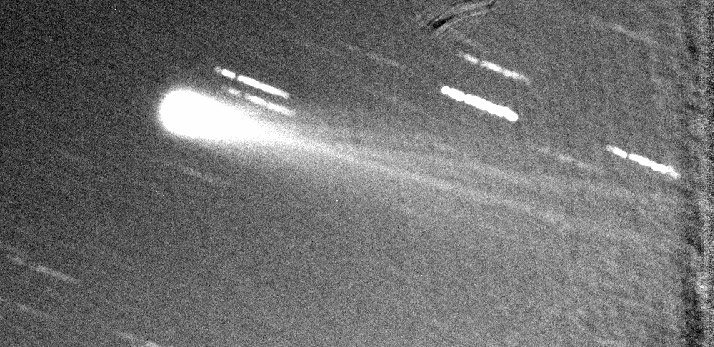
A Glimpse of Comet ISON
by Craig Cortis
Like most of us, I developed an interest in viewing ISON in early November, weeks before perihelion. I seldom keep careful records of observing sessions and can’t be certain (as I write this) of the precise date, but I’m fairly sure it would have been the morning of Monday, 11/11/13. If so, the comet’s position would have been about 2 degrees due south of Eta Virginis, according to an ephemeris obtained online about a week prior. A few times before 11/11, using 10 X 70 Fujinon Polaris binoculars, I’d tried to spot ISON after studying its projected positions on a detailed star atlas. Despite a few clear mornings in the first week of November, I simply could not discern the comet in 70mm aperture and regretted not trying my 4.2 inch Astroscan rich-field scope for the hunt. (Even the Astroscan can seem like too much work to take outside at 4:30 or 5:00 a.m. when it’s cold and you must leave for work by 5:30.)
Just 2 or 3 days before that Monday, I accidentally came across news and detailed information on a fairly recent comet discovery that was touted as being easily bright enough to see in a 50mm binocular, C/2013 R1 (Lovejoy). Its position was to be readily found just a few degrees WNW of the northernmost star in the “Sickle” asterism in Leo on the morning of 11/11, so I got up early and checked the sky. Mainly cloudy and hopeless at 4:35, naturally enough considering the usual weather curse that seems to accompany attempts to see transient sky objects. At least the Moon cooperated; it would’ve been First Quarter the day before and had set just after midnight, but the onset of morning astronomical twilight during my observing time window was a factor to work around, especially considering a viewing direction east.
I went outside a second time at 5:00 and beheld a timely “gift” – the sky had cleared, nearly thoroughly! This inspired me to grab a 10 X 50 binocular and head out for a look at Lovejoy, all the while thinking of the beginning of astronomical twilight and my brief time for observing. Just for the fun of it, I first trained the bino on ISON’s position in Virgo where I’d memorized the specific starfield, but saw no faint smudge. This was no surprise, of course, but it seemed worthy of a quick attempt. (Maybe ISON had brightened?) I then put the bino on the predicted spot for Lovejoy in Leo and was delighted to almost immediately see a bright, easily conspicuous, large snowball-like object exactly where predicted. This was so good in appearance that I decided it was time for more aperture and got out the Astroscan, which is what I commonly use to show people wide-field, low power views on public nights at Ladd Observatory. Lovejoy was an easy treat in the scope and I determined to follow it for as many days as possible thereafter, weather permitting.
Just before wrapping things up at around 5:10 to 5:15 a.m., I thought I’d give ISON another try; it’d be my first attempt with anything larger than 70mm aperture and the comet evidently had not brightened sufficiently by 11/11 to be viewable in instruments of a certain size or smaller. Besides, I already had the Astroscan set up, so why waste the chance? I pointed the scope over to the exact spot in Virgo and double-checked star patterns to assure a “fix” with respect to certain stars. Within a few seconds there seemed to be a mere suggestion of a ghostly, nearly invisible and elongated wisp of grayish-white at the correct position, but was I just imagining it because I so much wanted something to be there? After a few back-and-forth visual checks using averted vision, then direct vision, I became at least 95 percent sure that a nonstellar smudge of light was there; the Astroscan had done the trick. I’m writing this on the evening of 12/1/13 and will hope we’ll have a chance to see ISON post-perihelion, provided there’ll be anything much to see.



